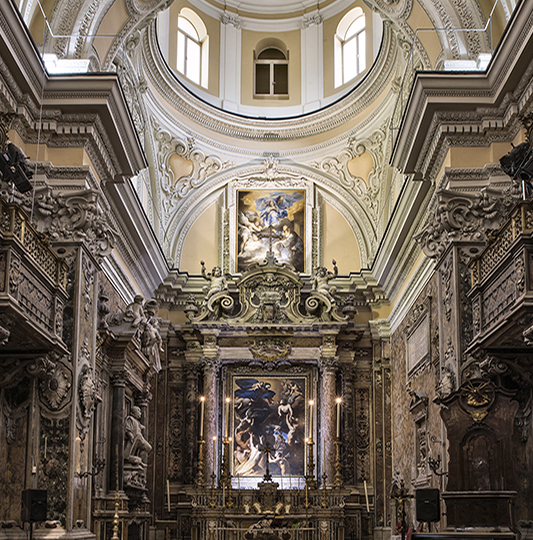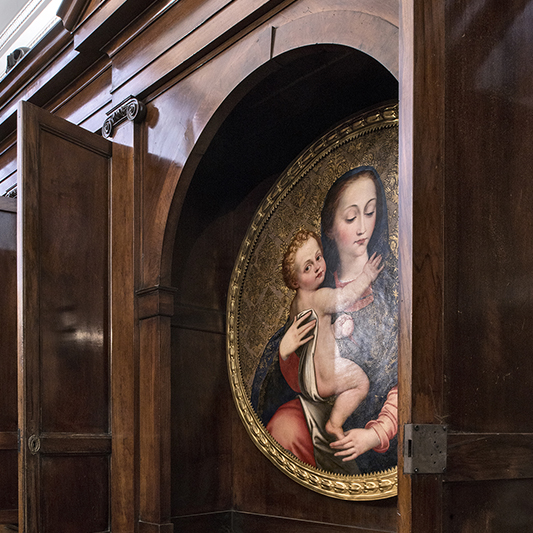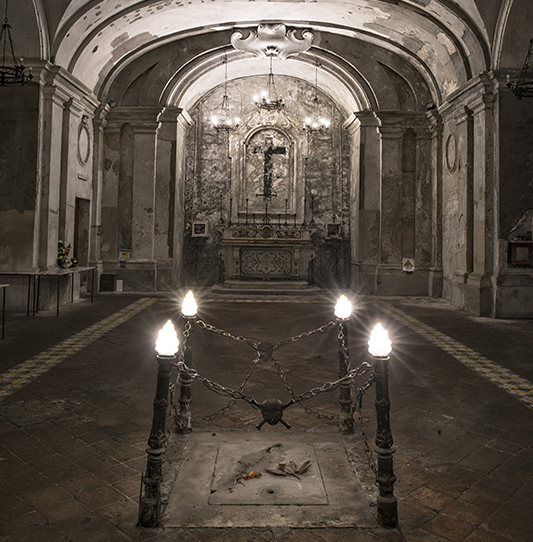A real journey into the cult of the "purgatory souls"
OPENING HOURS AND GUIDED TOURS
 Church, Museum, Underground Church
Church, Museum, Underground Church
Sunday – Friday: 10.00 – 2.00 pm
Saturday: 10.00 – 5.00 pm
Last admission: 1 hour before closing
Upper church free admission
 Guided tours in English:
Guided tours in English:
only on Saturdays at 11.00 a.m. with reservation
To book it is necessary to send an email to progettomuseo.purgatorioadarco@gmail.com
 Single ticket €7
Single ticket €7
Reduced entry €6
Entry for children (ages 7 to 13) €3
School group ticket (with guided tour) €5
Purgatorio ad Arco
“Pezzentelle” Souls Church
In the heart of the ancient center of Naples, along via dei Tribunali, there is the Church of Santa Maria delle Anime in Purgatory in Arco, known to the Neapolitan people as the church “de ” e cape ‘e morte” (the head of dead). Crossing the threshold begins a real journey in the Neapolitan culture between art, faith, life, death. From the small and beautiful church of the ‘600, which preserves the precious marble and winged skull of Dionisio Lazzari, together with masterpieces by Massimo Stanzione, Luca Giordano and Andrea Vaccaro, we descend into the ancient and grandiose hypogeum (the underground church) that still hosts the fascinating worship aimed at anonymous human remains that become special intermediaries for invocations, prayers, requests for intercessions. A small museum set up in the elegant sacristy completes the itinerary.


The Church
The worshipping of the souls of the Purgatory was one of the most important rituals of the counter-reformed church and the whole decorative apparatus of the Complex was conceived to remember, to visitors and faithfuls, that the souls of dead people were waiting for a prayer to be freed from the flames of the Purgatory and to be accepted in Heaven. The façade, the decoration of the church and of the Sacristy, the liturgical paraments recall the theme of the Purgatory; the whole iconographic project was dedicated to the theme of death by 1600s works of art: the Saint Joseph Transit (1650-51) by Andrea Vaccaro, located in the third left chapel; the Death of Saint Alessio (1661), one of the first masterpieces by Luca Giordano, in the third right chapel.
The Museum
The sacristy, Museum and the Oratory of the Immaculate.
The Museum of the Complex is located in the sacristy of the Church and in the Oratory of the Immaculate and it preserves a collection of paintings and artifacts dating to the XVII and XIX century. The collection is an interesting proof of the four hundreds years of existence of the Opera Pia as well as of the Neapolitan society and popular piety. A great variety of objects is exhibited in the museum – silvers, paintings, manuscripts – all made on the account of the Opera Pia. Particularly, among the beautiful 1600s and 1700s paintings, is remarkable a very high quality 1600s copy of the famous painting by Luis de Morales, representing the Virgin of Purity, whose original version is preserved in the convent of San Paolo Maggiore.


The Underground Church
Through an opening in the floor of the upper church, descending a steep staircase, it is possible to reach a wide space, a real lower church, one of the most well known places in Naples where, still today, is alive the ritual of the worshipping of the poor souls. In the center of the church is located an anonymous tomb, surrounded by black chains and barely enlightened by electric lights. Along the walls small niches, altars and candles witness the old ritual that raised spontaneously in the 1600s. Through a small corridor it is possible to reach the burial ground of the church were the remains of Lucia, the young soul particularly loved by Neapolitan people, are preserved in a sophisticated and fascinating altar. The dimensions of the lower church are impressive and the choice to deliberately contrast the decorative richness of the upper church with the austerity of the lower space is clear.
Info
Via Tribunali, 39 – 80138 Napoli
Free entrance to Church
Admission fee is to visit the Hypogeum and the museum in Upper Church (Winged skull, sacresty and oratory).
Every Saturday at 11.00 am there is a guided tour in English included in the entrance ticket, reservation is required
For reservations send mail to progettomuseo.purgatorioadarco@gmail.com
It is possible, for groups, to visit the Complex also outside the opening hours, on request, with different rates.
For more information, send an email or call.
Tel 081 440438 / 3715831130
email progettomuseo.purgatorioadarco@gmail.com

Purgatorio ad Arco

In the heart of the ancient center of Naples, along via dei Tribunali, there is the Church of Santa Maria delle Anime in Purgatory in Arco, known to the Neapolitan people as the church “de ” e cape ‘e morte” (the head of dead). Crossing the threshold begins a real journey in the Neapolitan culture between art, faith, life, death. From the small and beautiful church of the ‘600, which preserves the precious marble and winged skull of Dionisio Lazzari, together with masterpieces by Massimo Stanzione, Luca Giordano and Andrea Vaccaro, we descend into the ancient and grandiose hypogeum (the underground church) that still hosts the fascinating worship aimed at anonymous human remains that become special intermediaries for invocations, prayers, requests for intercessions. A small museum set up in the elegant sacristy completes the itinerary.
The Church

The worshipping of the souls of the Purgatory was one of the most important rituals of the counter-reformed church and the whole decorative apparatus of the Complex was conceived to remember, to visitors and faithfuls, that the souls of dead people were waiting for a prayer to be freed from the flames of the Purgatory and to be accepted in Heaven. The façade, the decoration of the church and of the Sacristy, the liturgical paraments recall the theme of the Purgatory; the whole iconographic project was dedicated to the theme of death by 1600s works of art: the Saint Joseph Transit (1650-51) by Andrea Vaccaro, located in the third left chapel; the Death of Saint Alessio (1661), one of the first masterpieces by Luca Giordano, in the third right chapel. Right above the main altar is located the beautiful painting by Massimo Stanzione The Madonna of the Purgatory Souls (1638-1642). Right below Stanzione’s painting there was the marble Winged Skull by Dioniso Lazzari, today located behind the altar. Above the triumph arch there is the Sant’Anna offers the Virgin to the Lord (1670) by Giacomo Farelli and, in the first left chapel, San Michele who defeats the Devil (1650) by Girolamo De Magistro.
The Museum

The sacristy, Museum and the Oratory of the Immaculate.
The Museum of the Complex is located in the sacristy of the Church and in the Oratory of the Immaculate and it preserves a collection of paintings and artifacts dating to the XVII and XIX century. The collection is an interesting proof of the four hundreds years of existence of the Opera Pia as well as of the Neapolitan society and popular piety. A great variety of objects is exhibited in the museum – silvers, paintings, manuscripts – all made on the account of the Opera Pia. Particularly, among the beautiful 1600s and 1700s paintings, is remarkable a very high quality 1600s copy of the famous painting by Luis de Morales, representing the Virgin of Purity, whose original version is preserved in the convent of San Paolo Maggiore.
The Underground Church

Through an opening in the floor of the upper church, descending a steep staircase, it is possible to reach a wide space, a real lower church, one of the most well known places in Naples where, still today, is alive the ritual of the worshipping of the poor souls. In the center of the church is located an anonymous tomb, surrounded by black chains and barely enlightened by electric lights. Along the walls small niches, altars and candles witness the old ritual that raised spontaneously in the 1600s. Through a small corridor it is possible to reach the burial ground of the church werethe remains of Lucia, the young soul particularly loved by Neapolitan people, are preserved in a sophisticated and fascinating altar. The dimensions of the lower church are impressive and the choice to deliberately contrast the decorative richness of the upper church with the austerity of the lower space is clear. As it has been proven by archive documents, the idea of including an underground church was conceived already in the first project of construction of the church. In fact, since the 1600s workshops and storage rooms located in the area were bought in order to have enough space for a burial ground for the members of the Congregation and for poor people. The Lower church has one aisle and a series of side chapels; in the 1700s it was enlarged and covered by a rich decoration made of majolica tiles painted with skulls, bones and flowers, made by the artisan Giuseppe Barberio.
Info

Church, Museum, Underground Church:
Monday – Saturday: 10.00 a.m./2.00 p.m
(last entry 1.15 p.m.)
Closed on Sunday
Free entrance to Church
Admission fee is to visit the Hypogeum and the museum in Upper Church (Winged skull, sacresty and oratory).
It is possible, for groups, to visit the Complex also outside the opening hours, on request, with different rates.
For more information, send an email or call.
